Vicarious Liability: When is a Company Liable for Employee Torts?
VerifiedAdded on 2023/04/22
|7
|2066
|440
Essay
AI Summary
This essay critically analyzes the concept of vicarious liability, focusing on whether a company should always be held responsible for the tortious actions of its employees, especially when those actions occur within the scope of their employment. The essay defines vicarious liability, highlighting the employer-employee relationship and the conditions under which a company can be held liable, such as when the employee commits a tort during their employment and within the scope of their job. It examines key legal precedents like Dutton v Bognor Regis Urban District Council, Century Insurance v NI Road Transport Board, and Limpus v London General Omnibus Co, demonstrating the factors courts consider, including the 'Control Test,' 'Organisation/Integration test' and 'Economic Reality Test'. The essay also discusses instances where a company might not be liable, such as when an employee acts outside the scope of their employment (Beard v London Omnibus Co). Furthermore, the essay highlights the rights of the company to sue the employee for negligence as seen in Northwestern Mutual Insurance Co. v. J.T. O'Bryan and Co. The essay concludes that while a company is generally liable for employee actions within the scope of employment, certain conditions must be met, and the company can also seek recourse against the employee, emphasizing the balance between compensating injured parties and assigning responsibility.
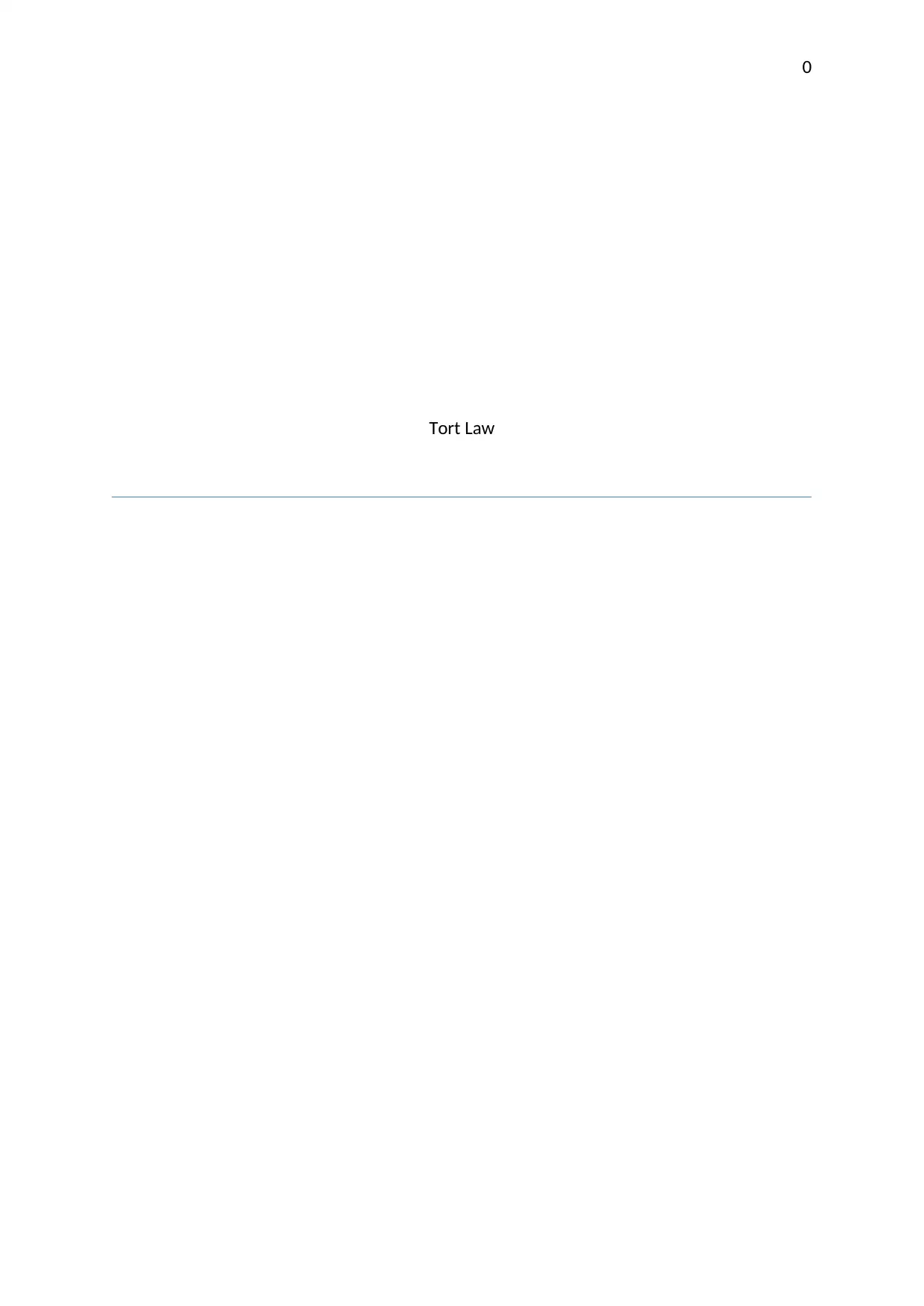
0
Tort Law
Tort Law
Paraphrase This Document
Need a fresh take? Get an instant paraphrase of this document with our AI Paraphraser
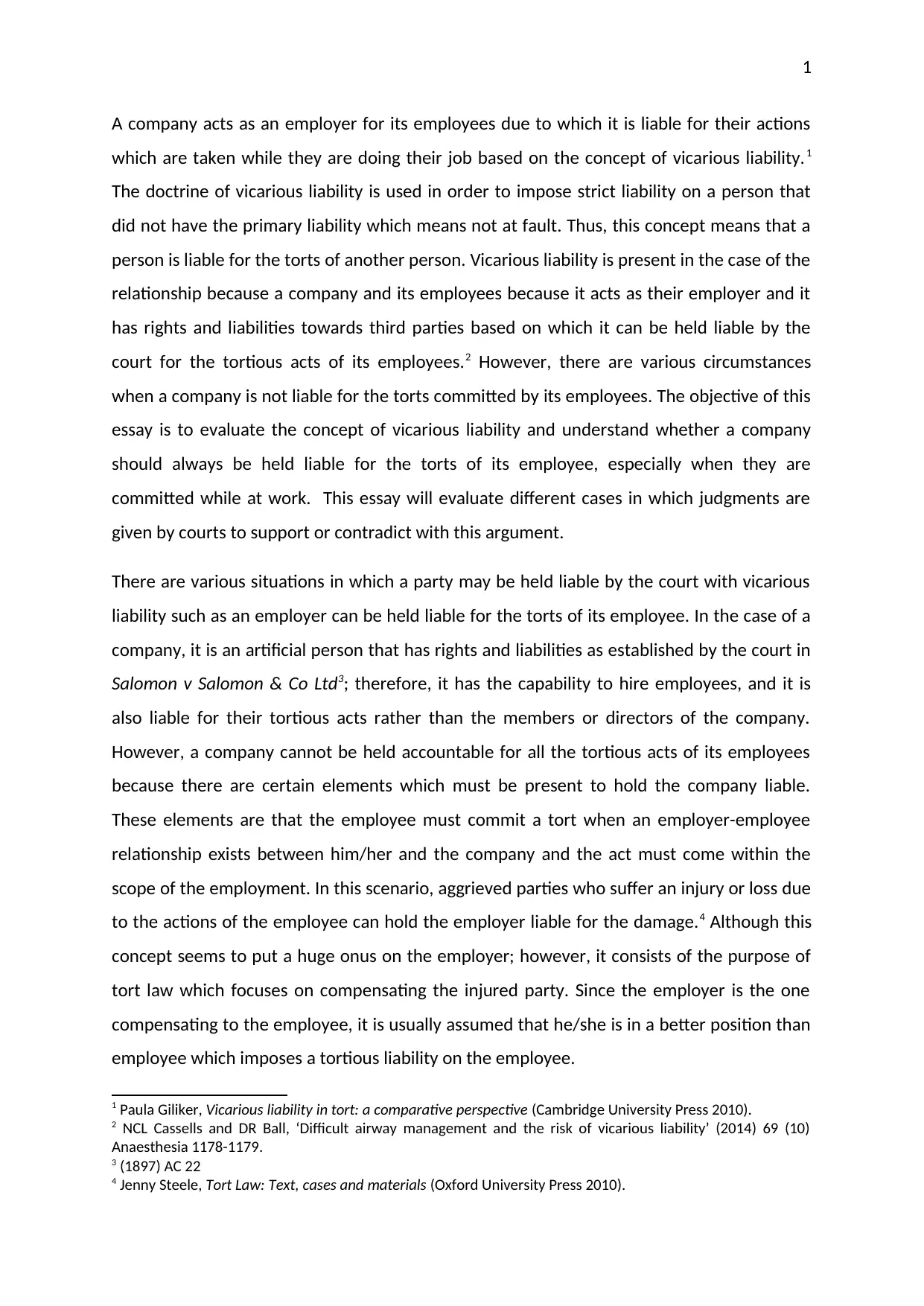
1
A company acts as an employer for its employees due to which it is liable for their actions
which are taken while they are doing their job based on the concept of vicarious liability.1
The doctrine of vicarious liability is used in order to impose strict liability on a person that
did not have the primary liability which means not at fault. Thus, this concept means that a
person is liable for the torts of another person. Vicarious liability is present in the case of the
relationship because a company and its employees because it acts as their employer and it
has rights and liabilities towards third parties based on which it can be held liable by the
court for the tortious acts of its employees.2 However, there are various circumstances
when a company is not liable for the torts committed by its employees. The objective of this
essay is to evaluate the concept of vicarious liability and understand whether a company
should always be held liable for the torts of its employee, especially when they are
committed while at work. This essay will evaluate different cases in which judgments are
given by courts to support or contradict with this argument.
There are various situations in which a party may be held liable by the court with vicarious
liability such as an employer can be held liable for the torts of its employee. In the case of a
company, it is an artificial person that has rights and liabilities as established by the court in
Salomon v Salomon & Co Ltd3; therefore, it has the capability to hire employees, and it is
also liable for their tortious acts rather than the members or directors of the company.
However, a company cannot be held accountable for all the tortious acts of its employees
because there are certain elements which must be present to hold the company liable.
These elements are that the employee must commit a tort when an employer-employee
relationship exists between him/her and the company and the act must come within the
scope of the employment. In this scenario, aggrieved parties who suffer an injury or loss due
to the actions of the employee can hold the employer liable for the damage.4 Although this
concept seems to put a huge onus on the employer; however, it consists of the purpose of
tort law which focuses on compensating the injured party. Since the employer is the one
compensating to the employee, it is usually assumed that he/she is in a better position than
employee which imposes a tortious liability on the employee.
1 Paula Giliker, Vicarious liability in tort: a comparative perspective (Cambridge University Press 2010).
2 NCL Cassells and DR Ball, ‘Difficult airway management and the risk of vicarious liability’ (2014) 69 (10)
Anaesthesia 1178-1179.
3 (1897) AC 22
4 Jenny Steele, Tort Law: Text, cases and materials (Oxford University Press 2010).
A company acts as an employer for its employees due to which it is liable for their actions
which are taken while they are doing their job based on the concept of vicarious liability.1
The doctrine of vicarious liability is used in order to impose strict liability on a person that
did not have the primary liability which means not at fault. Thus, this concept means that a
person is liable for the torts of another person. Vicarious liability is present in the case of the
relationship because a company and its employees because it acts as their employer and it
has rights and liabilities towards third parties based on which it can be held liable by the
court for the tortious acts of its employees.2 However, there are various circumstances
when a company is not liable for the torts committed by its employees. The objective of this
essay is to evaluate the concept of vicarious liability and understand whether a company
should always be held liable for the torts of its employee, especially when they are
committed while at work. This essay will evaluate different cases in which judgments are
given by courts to support or contradict with this argument.
There are various situations in which a party may be held liable by the court with vicarious
liability such as an employer can be held liable for the torts of its employee. In the case of a
company, it is an artificial person that has rights and liabilities as established by the court in
Salomon v Salomon & Co Ltd3; therefore, it has the capability to hire employees, and it is
also liable for their tortious acts rather than the members or directors of the company.
However, a company cannot be held accountable for all the tortious acts of its employees
because there are certain elements which must be present to hold the company liable.
These elements are that the employee must commit a tort when an employer-employee
relationship exists between him/her and the company and the act must come within the
scope of the employment. In this scenario, aggrieved parties who suffer an injury or loss due
to the actions of the employee can hold the employer liable for the damage.4 Although this
concept seems to put a huge onus on the employer; however, it consists of the purpose of
tort law which focuses on compensating the injured party. Since the employer is the one
compensating to the employee, it is usually assumed that he/she is in a better position than
employee which imposes a tortious liability on the employee.
1 Paula Giliker, Vicarious liability in tort: a comparative perspective (Cambridge University Press 2010).
2 NCL Cassells and DR Ball, ‘Difficult airway management and the risk of vicarious liability’ (2014) 69 (10)
Anaesthesia 1178-1179.
3 (1897) AC 22
4 Jenny Steele, Tort Law: Text, cases and materials (Oxford University Press 2010).
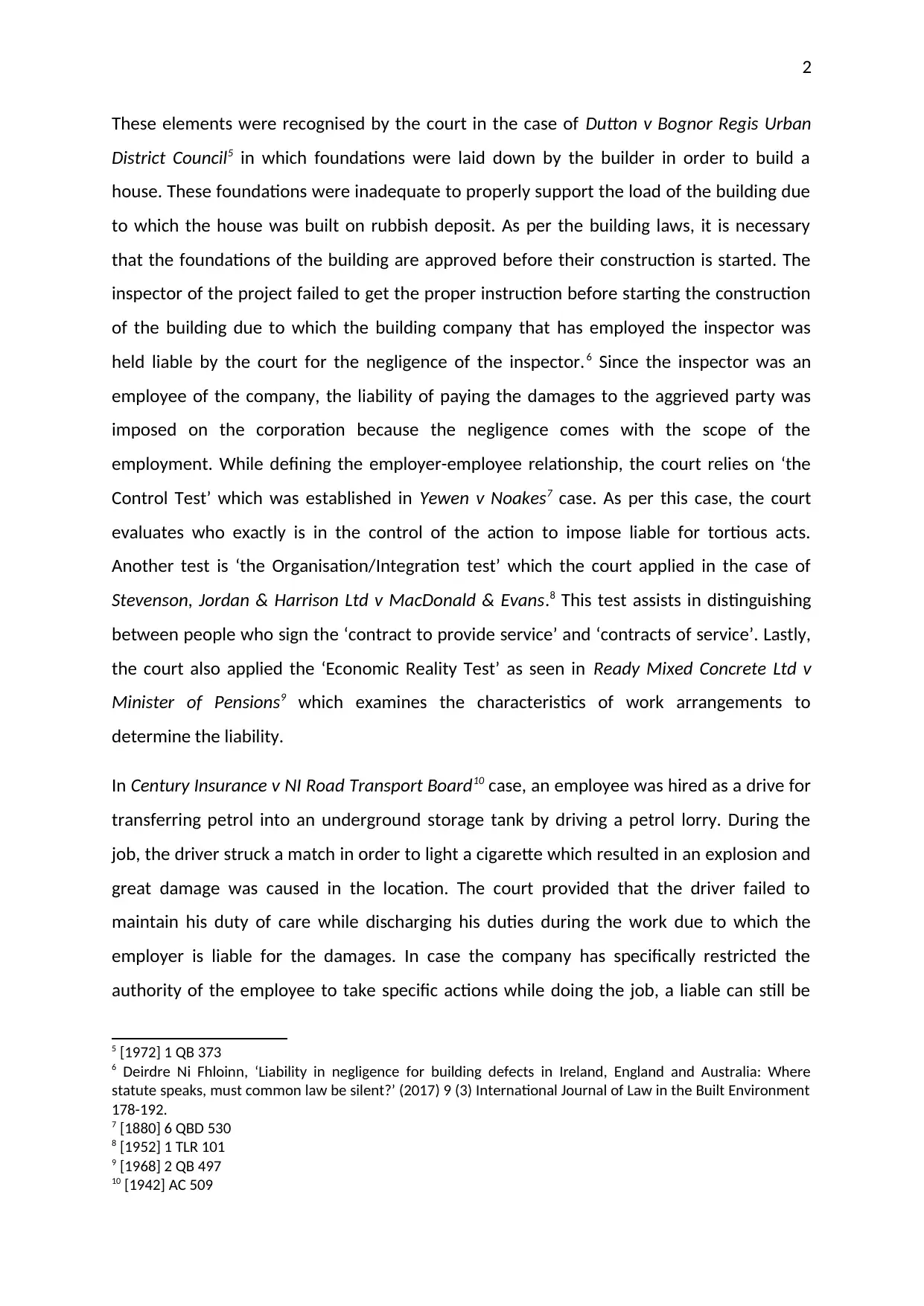
2
These elements were recognised by the court in the case of Dutton v Bognor Regis Urban
District Council5 in which foundations were laid down by the builder in order to build a
house. These foundations were inadequate to properly support the load of the building due
to which the house was built on rubbish deposit. As per the building laws, it is necessary
that the foundations of the building are approved before their construction is started. The
inspector of the project failed to get the proper instruction before starting the construction
of the building due to which the building company that has employed the inspector was
held liable by the court for the negligence of the inspector.6 Since the inspector was an
employee of the company, the liability of paying the damages to the aggrieved party was
imposed on the corporation because the negligence comes with the scope of the
employment. While defining the employer-employee relationship, the court relies on ‘the
Control Test’ which was established in Yewen v Noakes7 case. As per this case, the court
evaluates who exactly is in the control of the action to impose liable for tortious acts.
Another test is ‘the Organisation/Integration test’ which the court applied in the case of
Stevenson, Jordan & Harrison Ltd v MacDonald & Evans.8 This test assists in distinguishing
between people who sign the ‘contract to provide service’ and ‘contracts of service’. Lastly,
the court also applied the ‘Economic Reality Test’ as seen in Ready Mixed Concrete Ltd v
Minister of Pensions9 which examines the characteristics of work arrangements to
determine the liability.
In Century Insurance v NI Road Transport Board10 case, an employee was hired as a drive for
transferring petrol into an underground storage tank by driving a petrol lorry. During the
job, the driver struck a match in order to light a cigarette which resulted in an explosion and
great damage was caused in the location. The court provided that the driver failed to
maintain his duty of care while discharging his duties during the work due to which the
employer is liable for the damages. In case the company has specifically restricted the
authority of the employee to take specific actions while doing the job, a liable can still be
5 [1972] 1 QB 373
6 Deirdre Ni Fhloinn, ‘Liability in negligence for building defects in Ireland, England and Australia: Where
statute speaks, must common law be silent?’ (2017) 9 (3) International Journal of Law in the Built Environment
178-192.
7 [1880] 6 QBD 530
8 [1952] 1 TLR 101
9 [1968] 2 QB 497
10 [1942] AC 509
These elements were recognised by the court in the case of Dutton v Bognor Regis Urban
District Council5 in which foundations were laid down by the builder in order to build a
house. These foundations were inadequate to properly support the load of the building due
to which the house was built on rubbish deposit. As per the building laws, it is necessary
that the foundations of the building are approved before their construction is started. The
inspector of the project failed to get the proper instruction before starting the construction
of the building due to which the building company that has employed the inspector was
held liable by the court for the negligence of the inspector.6 Since the inspector was an
employee of the company, the liability of paying the damages to the aggrieved party was
imposed on the corporation because the negligence comes with the scope of the
employment. While defining the employer-employee relationship, the court relies on ‘the
Control Test’ which was established in Yewen v Noakes7 case. As per this case, the court
evaluates who exactly is in the control of the action to impose liable for tortious acts.
Another test is ‘the Organisation/Integration test’ which the court applied in the case of
Stevenson, Jordan & Harrison Ltd v MacDonald & Evans.8 This test assists in distinguishing
between people who sign the ‘contract to provide service’ and ‘contracts of service’. Lastly,
the court also applied the ‘Economic Reality Test’ as seen in Ready Mixed Concrete Ltd v
Minister of Pensions9 which examines the characteristics of work arrangements to
determine the liability.
In Century Insurance v NI Road Transport Board10 case, an employee was hired as a drive for
transferring petrol into an underground storage tank by driving a petrol lorry. During the
job, the driver struck a match in order to light a cigarette which resulted in an explosion and
great damage was caused in the location. The court provided that the driver failed to
maintain his duty of care while discharging his duties during the work due to which the
employer is liable for the damages. In case the company has specifically restricted the
authority of the employee to take specific actions while doing the job, a liable can still be
5 [1972] 1 QB 373
6 Deirdre Ni Fhloinn, ‘Liability in negligence for building defects in Ireland, England and Australia: Where
statute speaks, must common law be silent?’ (2017) 9 (3) International Journal of Law in the Built Environment
178-192.
7 [1880] 6 QBD 530
8 [1952] 1 TLR 101
9 [1968] 2 QB 497
10 [1942] AC 509
⊘ This is a preview!⊘
Do you want full access?
Subscribe today to unlock all pages.

Trusted by 1+ million students worldwide
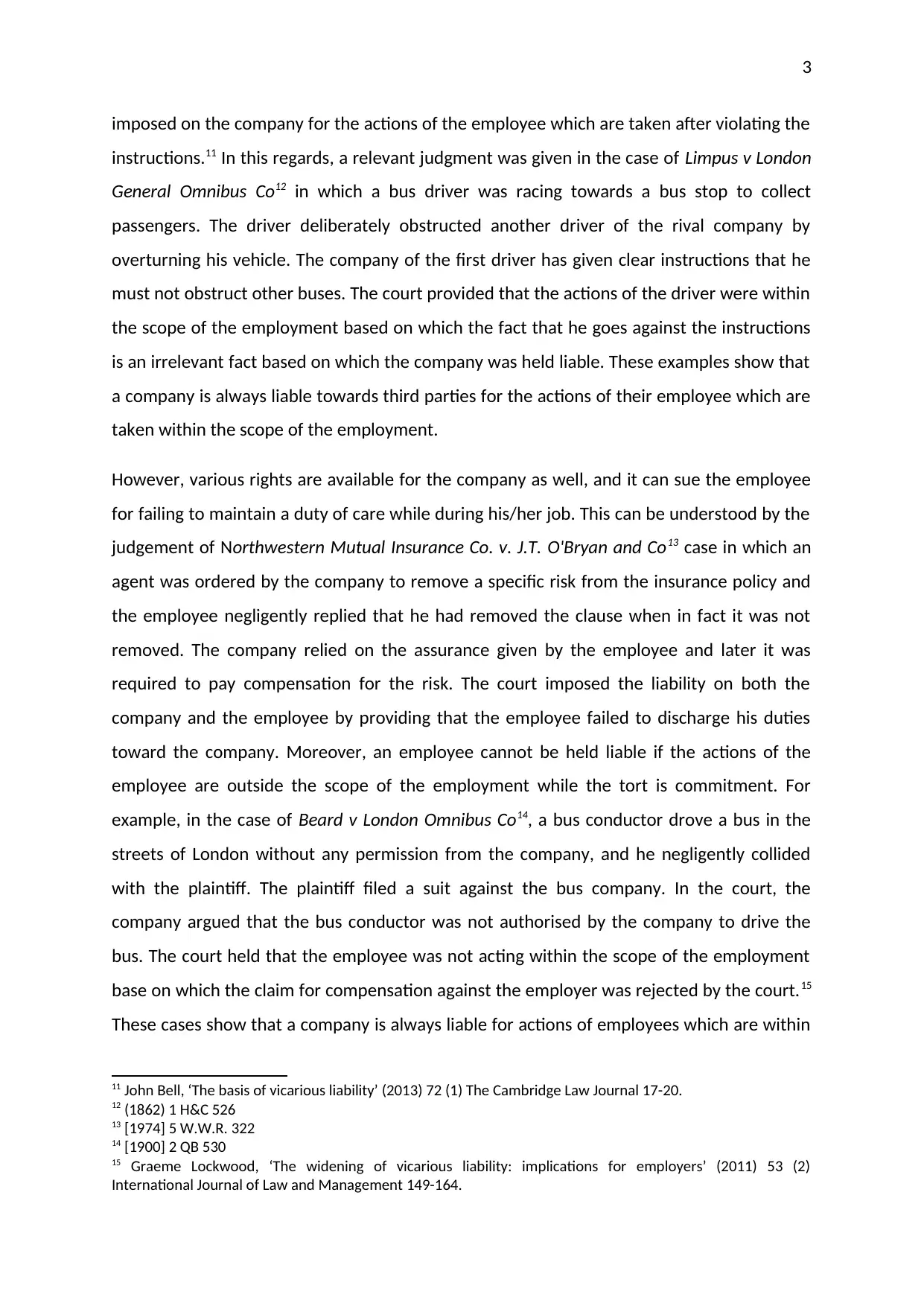
3
imposed on the company for the actions of the employee which are taken after violating the
instructions.11 In this regards, a relevant judgment was given in the case of Limpus v London
General Omnibus Co12 in which a bus driver was racing towards a bus stop to collect
passengers. The driver deliberately obstructed another driver of the rival company by
overturning his vehicle. The company of the first driver has given clear instructions that he
must not obstruct other buses. The court provided that the actions of the driver were within
the scope of the employment based on which the fact that he goes against the instructions
is an irrelevant fact based on which the company was held liable. These examples show that
a company is always liable towards third parties for the actions of their employee which are
taken within the scope of the employment.
However, various rights are available for the company as well, and it can sue the employee
for failing to maintain a duty of care while during his/her job. This can be understood by the
judgement of Northwestern Mutual Insurance Co. v. J.T. O'Bryan and Co13 case in which an
agent was ordered by the company to remove a specific risk from the insurance policy and
the employee negligently replied that he had removed the clause when in fact it was not
removed. The company relied on the assurance given by the employee and later it was
required to pay compensation for the risk. The court imposed the liability on both the
company and the employee by providing that the employee failed to discharge his duties
toward the company. Moreover, an employee cannot be held liable if the actions of the
employee are outside the scope of the employment while the tort is commitment. For
example, in the case of Beard v London Omnibus Co14, a bus conductor drove a bus in the
streets of London without any permission from the company, and he negligently collided
with the plaintiff. The plaintiff filed a suit against the bus company. In the court, the
company argued that the bus conductor was not authorised by the company to drive the
bus. The court held that the employee was not acting within the scope of the employment
base on which the claim for compensation against the employer was rejected by the court.15
These cases show that a company is always liable for actions of employees which are within
11 John Bell, ‘The basis of vicarious liability’ (2013) 72 (1) The Cambridge Law Journal 17-20.
12 (1862) 1 H&C 526
13 [1974] 5 W.W.R. 322
14 [1900] 2 QB 530
15 Graeme Lockwood, ‘The widening of vicarious liability: implications for employers’ (2011) 53 (2)
International Journal of Law and Management 149-164.
imposed on the company for the actions of the employee which are taken after violating the
instructions.11 In this regards, a relevant judgment was given in the case of Limpus v London
General Omnibus Co12 in which a bus driver was racing towards a bus stop to collect
passengers. The driver deliberately obstructed another driver of the rival company by
overturning his vehicle. The company of the first driver has given clear instructions that he
must not obstruct other buses. The court provided that the actions of the driver were within
the scope of the employment based on which the fact that he goes against the instructions
is an irrelevant fact based on which the company was held liable. These examples show that
a company is always liable towards third parties for the actions of their employee which are
taken within the scope of the employment.
However, various rights are available for the company as well, and it can sue the employee
for failing to maintain a duty of care while during his/her job. This can be understood by the
judgement of Northwestern Mutual Insurance Co. v. J.T. O'Bryan and Co13 case in which an
agent was ordered by the company to remove a specific risk from the insurance policy and
the employee negligently replied that he had removed the clause when in fact it was not
removed. The company relied on the assurance given by the employee and later it was
required to pay compensation for the risk. The court imposed the liability on both the
company and the employee by providing that the employee failed to discharge his duties
toward the company. Moreover, an employee cannot be held liable if the actions of the
employee are outside the scope of the employment while the tort is commitment. For
example, in the case of Beard v London Omnibus Co14, a bus conductor drove a bus in the
streets of London without any permission from the company, and he negligently collided
with the plaintiff. The plaintiff filed a suit against the bus company. In the court, the
company argued that the bus conductor was not authorised by the company to drive the
bus. The court held that the employee was not acting within the scope of the employment
base on which the claim for compensation against the employer was rejected by the court.15
These cases show that a company is always liable for actions of employees which are within
11 John Bell, ‘The basis of vicarious liability’ (2013) 72 (1) The Cambridge Law Journal 17-20.
12 (1862) 1 H&C 526
13 [1974] 5 W.W.R. 322
14 [1900] 2 QB 530
15 Graeme Lockwood, ‘The widening of vicarious liability: implications for employers’ (2011) 53 (2)
International Journal of Law and Management 149-164.
Paraphrase This Document
Need a fresh take? Get an instant paraphrase of this document with our AI Paraphraser
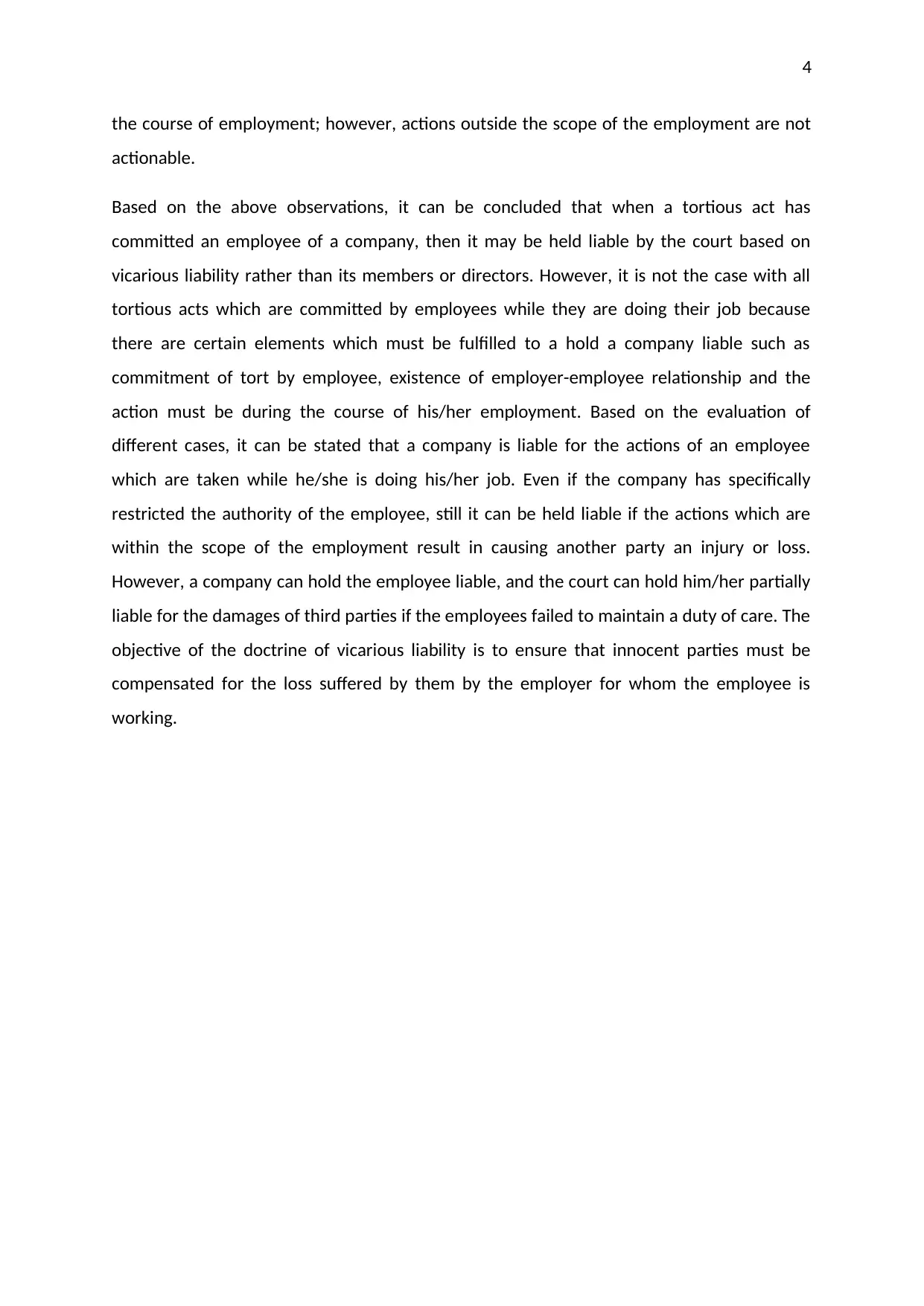
4
the course of employment; however, actions outside the scope of the employment are not
actionable.
Based on the above observations, it can be concluded that when a tortious act has
committed an employee of a company, then it may be held liable by the court based on
vicarious liability rather than its members or directors. However, it is not the case with all
tortious acts which are committed by employees while they are doing their job because
there are certain elements which must be fulfilled to a hold a company liable such as
commitment of tort by employee, existence of employer-employee relationship and the
action must be during the course of his/her employment. Based on the evaluation of
different cases, it can be stated that a company is liable for the actions of an employee
which are taken while he/she is doing his/her job. Even if the company has specifically
restricted the authority of the employee, still it can be held liable if the actions which are
within the scope of the employment result in causing another party an injury or loss.
However, a company can hold the employee liable, and the court can hold him/her partially
liable for the damages of third parties if the employees failed to maintain a duty of care. The
objective of the doctrine of vicarious liability is to ensure that innocent parties must be
compensated for the loss suffered by them by the employer for whom the employee is
working.
the course of employment; however, actions outside the scope of the employment are not
actionable.
Based on the above observations, it can be concluded that when a tortious act has
committed an employee of a company, then it may be held liable by the court based on
vicarious liability rather than its members or directors. However, it is not the case with all
tortious acts which are committed by employees while they are doing their job because
there are certain elements which must be fulfilled to a hold a company liable such as
commitment of tort by employee, existence of employer-employee relationship and the
action must be during the course of his/her employment. Based on the evaluation of
different cases, it can be stated that a company is liable for the actions of an employee
which are taken while he/she is doing his/her job. Even if the company has specifically
restricted the authority of the employee, still it can be held liable if the actions which are
within the scope of the employment result in causing another party an injury or loss.
However, a company can hold the employee liable, and the court can hold him/her partially
liable for the damages of third parties if the employees failed to maintain a duty of care. The
objective of the doctrine of vicarious liability is to ensure that innocent parties must be
compensated for the loss suffered by them by the employer for whom the employee is
working.
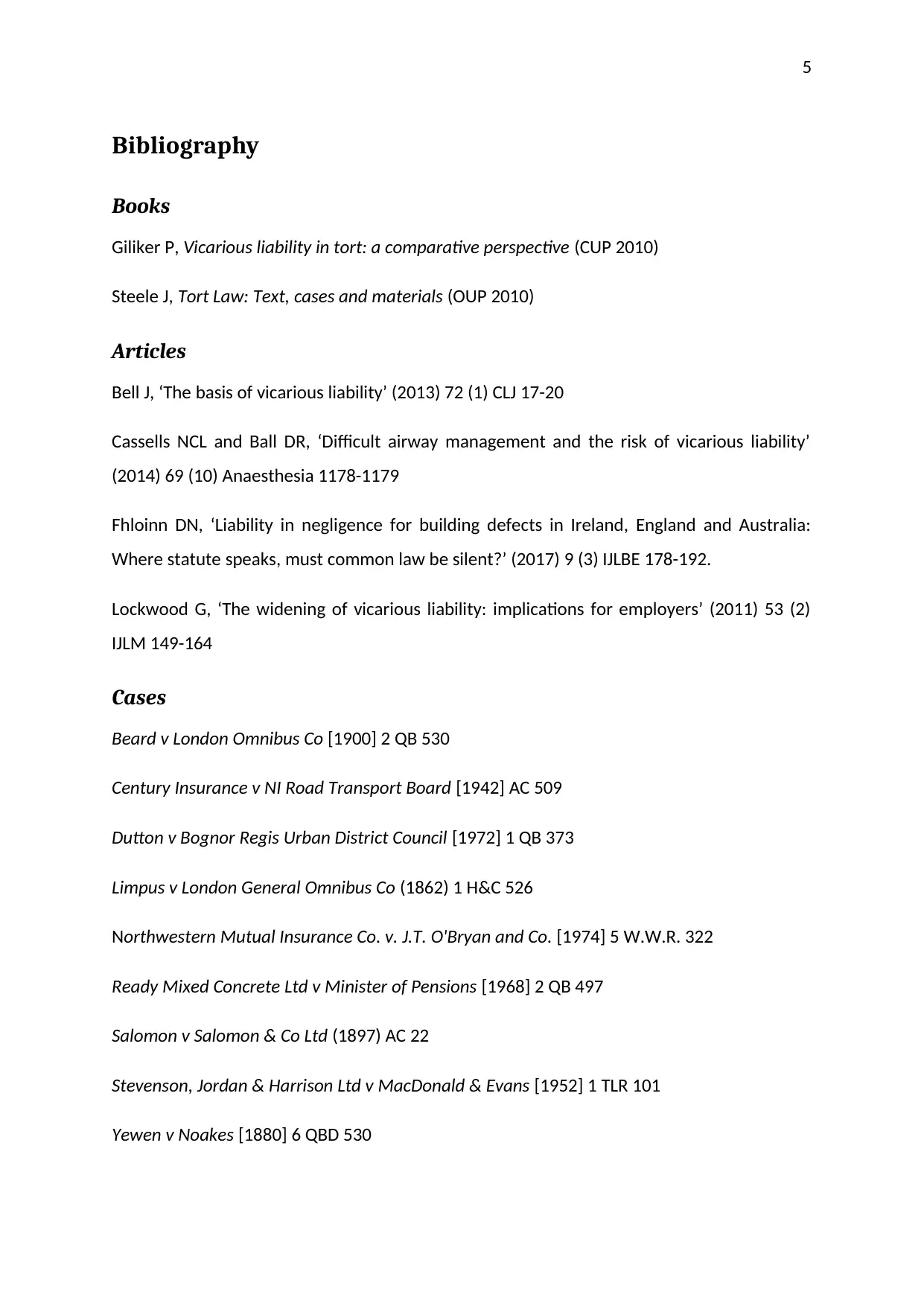
5
Bibliography
Books
Giliker P, Vicarious liability in tort: a comparative perspective (CUP 2010)
Steele J, Tort Law: Text, cases and materials (OUP 2010)
Articles
Bell J, ‘The basis of vicarious liability’ (2013) 72 (1) CLJ 17-20
Cassells NCL and Ball DR, ‘Difficult airway management and the risk of vicarious liability’
(2014) 69 (10) Anaesthesia 1178-1179
Fhloinn DN, ‘Liability in negligence for building defects in Ireland, England and Australia:
Where statute speaks, must common law be silent?’ (2017) 9 (3) IJLBE 178-192.
Lockwood G, ‘The widening of vicarious liability: implications for employers’ (2011) 53 (2)
IJLM 149-164
Cases
Beard v London Omnibus Co [1900] 2 QB 530
Century Insurance v NI Road Transport Board [1942] AC 509
Dutton v Bognor Regis Urban District Council [1972] 1 QB 373
Limpus v London General Omnibus Co (1862) 1 H&C 526
Northwestern Mutual Insurance Co. v. J.T. O'Bryan and Co. [1974] 5 W.W.R. 322
Ready Mixed Concrete Ltd v Minister of Pensions [1968] 2 QB 497
Salomon v Salomon & Co Ltd (1897) AC 22
Stevenson, Jordan & Harrison Ltd v MacDonald & Evans [1952] 1 TLR 101
Yewen v Noakes [1880] 6 QBD 530
Bibliography
Books
Giliker P, Vicarious liability in tort: a comparative perspective (CUP 2010)
Steele J, Tort Law: Text, cases and materials (OUP 2010)
Articles
Bell J, ‘The basis of vicarious liability’ (2013) 72 (1) CLJ 17-20
Cassells NCL and Ball DR, ‘Difficult airway management and the risk of vicarious liability’
(2014) 69 (10) Anaesthesia 1178-1179
Fhloinn DN, ‘Liability in negligence for building defects in Ireland, England and Australia:
Where statute speaks, must common law be silent?’ (2017) 9 (3) IJLBE 178-192.
Lockwood G, ‘The widening of vicarious liability: implications for employers’ (2011) 53 (2)
IJLM 149-164
Cases
Beard v London Omnibus Co [1900] 2 QB 530
Century Insurance v NI Road Transport Board [1942] AC 509
Dutton v Bognor Regis Urban District Council [1972] 1 QB 373
Limpus v London General Omnibus Co (1862) 1 H&C 526
Northwestern Mutual Insurance Co. v. J.T. O'Bryan and Co. [1974] 5 W.W.R. 322
Ready Mixed Concrete Ltd v Minister of Pensions [1968] 2 QB 497
Salomon v Salomon & Co Ltd (1897) AC 22
Stevenson, Jordan & Harrison Ltd v MacDonald & Evans [1952] 1 TLR 101
Yewen v Noakes [1880] 6 QBD 530
⊘ This is a preview!⊘
Do you want full access?
Subscribe today to unlock all pages.

Trusted by 1+ million students worldwide

6
1 out of 7
Related Documents
Your All-in-One AI-Powered Toolkit for Academic Success.
+13062052269
info@desklib.com
Available 24*7 on WhatsApp / Email
![[object Object]](/_next/static/media/star-bottom.7253800d.svg)
Unlock your academic potential
Copyright © 2020–2025 A2Z Services. All Rights Reserved. Developed and managed by ZUCOL.





